by tmoffett | Sep 23, 2010 | Black and White, Composition, Landscape, Photo tips
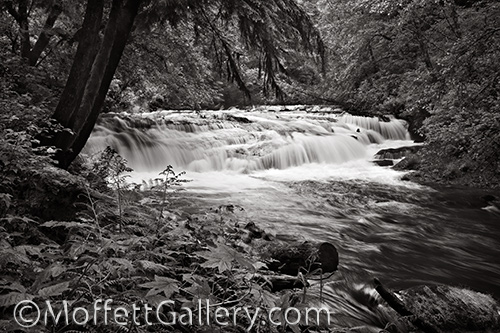
Knowles Creek
One of the most beautiful small rivers I have visited is Knowles Creek in western Oregon. One summer afternoon Christeena and I took a small hike along its banks, and along one section we walked there was nearly a mile of nonstop, staircase type waterfalls. There was nearly too much water to get nice photographs. When it comes to shooting waterfalls, I prefer just a little water as it tends to photograph better than a whole lot of water. When there is too much flow, the water just turns to a white, textureless streak. With less water a soft, ribbon like effect happens. It is much more interesting that way. You can almost feel the flow of the water.
There is just something about kicking back and relaxing on the banks of a river. The sound of the running water and the fresh air of the outdoors is so peaceful and nice. Even the occasional rainfall that came down didn’t disrupt the feeling in the air. I could hang out in the outdoors year round without a problem. It is my kind of life. Just me, my family and my camera. Wouldn’t that be nice!
by tmoffett | Sep 22, 2010 | Black and White, Composition, Landscape, Photographic Philosophy
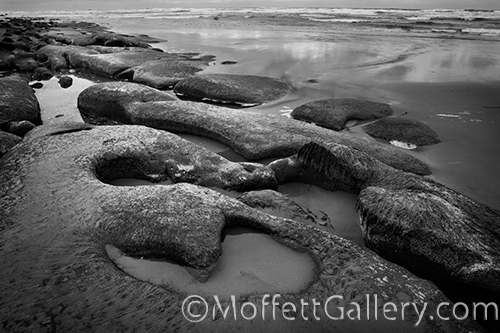
Ebb Tide, Ona Beach, Oregon
This past summer was very productive. I had many opportunities to photograph and not a lot of time to process the images. Here it is the middle of September and I am still working on files that were shot several months ago. I just processed this image last night, and as I was reviewing my files, wondered how I missed this on the first round of editing. The shapes, the reflections, the storm moving in, it all seems to work together.
The first time I went to Ona Beach I got all set up, camera on the tripod, composed and then came the downpour, before I even got off an exposure. I had never seen a storm move in so fast as that one did. So I went back the next day. It was incredible. The stones on the beach, carved by the water as it came and went with the tide, were dotted with pockets of water left by the receding tide, surrounded by mossy growth unlike anything I had ever seen before. It was really cool. The light was low and soft, as the sun was covered with light clouds. It had been raining but was starting to break up. I couldn’t have asked for a better day at the beach. And this beach, I could go back to over and over and never tire of it.
The calm after a storm as the clouds lighten and the sun begins to break through, the smell of fresh, clean air and the soft light, these are feelings that I like to show and have the viewer feel in my landscape photographs. If I feel them, I can create them. It is all about photographing from the heart. If I am constantly thinking about the technique to be used, then I will fail to capture a feeling or emotion. I must know the technical aspects of the process intuitively. It must be a part of me, then, and only then will I begin to create images with meaning. Many photographers think that it is all about technique, when really it is all about feeling. I must feel the image first, then I can create it.
by tmoffett | Sep 21, 2010 | Color, Landscape, Ramblings
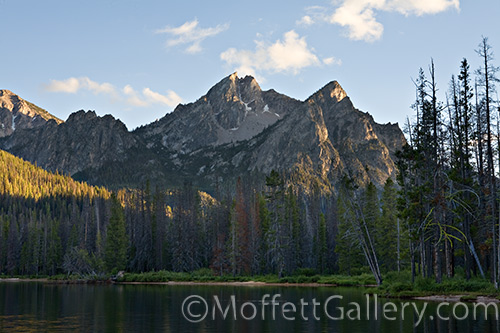
McGowan Peak
This view of McGowan Peak is taken from one of my favorite places on earth, Stanley Lake. It is a beautiful, quiet lake nestled in the Sawtooth Mountains. The cool, crisp mornings in the summertime are refreshing. When it heats up in the valley, Stanley is the place to go! The fishing is good and the photography opportunities are endless.
Some of my other favorite place that I have been, and not necessarily in this order are:
1. Kauai
2. Yachats, Oregon
3. Calf Creek Falls near Escalante, Utah
4. Cannon Beach, Oregon
5. Jackson Hole, Wyoming
Some of the places I hope to visit and photograph someday:
1. Alaska
2. China
3. Maine
4. Australia
5. Italy
I enjoy photographing my local area. I feel that I get to know it and can put more feeling and passion into it, but if the opportunity comes up to go to one of the above mentioned places, I am there!
by tmoffett | Sep 19, 2010 | Color, Composition, Landscape, Photo tips
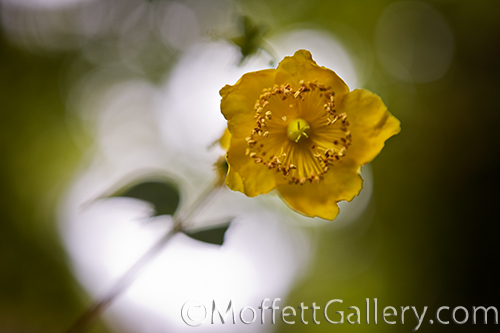
Framed by the light
When it comes to photographic composition, there is no rule greater than the Rule of Thirds. This rule of composition is not new. It stems from the Fibonacci Theory, also known as the Golden Mean, the Golden Ratio or the Fibonacci Spiral. It is a pattern in nature in which a spiral galaxy is laid out, the arc a hawk takes when diving at its prey and even a sunflower seed follows this patten when it grows. It is a pattern that we see everyday in nature, therefore it only makes sense that because we subconsciously are aware of it, our photographic compositions will be stronger if we apply this theory to them.
In a nutshell, the Rule of Thirds is a lazy mans Fibonacci Curve. It is not exact, but close. I think if we are aware of this theory and then compose our images from the heart, not from a grid, more often than not the image will line up with the Fibonacci curve. What the rule of thirds states is that if we divide the frame into thirds, both horizontally and vertically, the intersecting points are the strongest points in the composition. Our subject should then be placed at on of those points. The following is an illustration of the Rule of Thirds.

The intersecting points onthe grid are the strongest points to place the main subject.
This is the first theory that I discuss with my classes in their composition unit, as it can be applied to almost any photographic situation. This is the rule that we build on to make even better photographs throughout the year. As we apply line, framing and other compositional rules and concepts of design in our photography, we can still use the rule of thirds along with them to make our photographs even stronger.
by tmoffett | Sep 17, 2010 | Color, Landscape, Photo tips
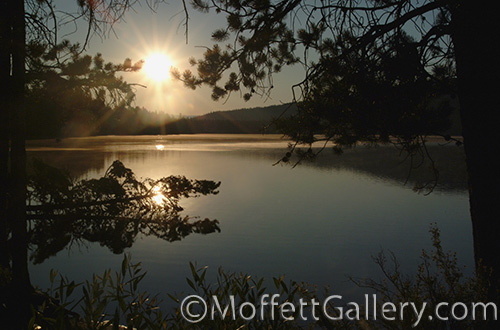
Stanley Lake Sunrise
I have been told numerous times that you can’t shoot into the sun. I remember many a time at a wedding that someone would approach me while I am photographing the bride and groom and mention that the sun is at their backs. “Your pictures won’t turn out,” they say. Annoying. Yes. But I would always just respond with, “Trust me. They are doing just fine!” Then when they see the results they are amazed.
I love landscape photographs with a monochromatic color scheme, and backlighting is one way to achieve that, as you can see from this image. I like to get up before sunrise and shoot the first hour of light. With the low sun, I can get lots of images with this wonderful light quality. It is dramatic and moody, yet still low enough contrast to maintain detail where I want it. this is something that is not possible at mid-day. Early morning and late evening. The perfect light.








Recent Comments